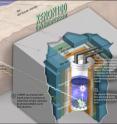Search for dark matter narrowed by new data from XENON100
Today, scientists from the XENON collaboration announced the result from their search for the elusive component of our universe known as dark matter. After analyzing one hundred days of data taken with the XENON100 experiment, they see no evidence for the existence of Weakly Interacting Massive Particles (WIMPs), the leading candidates for the mysterious dark matter. The XENON100 experiment is operated deep underground at the Gran Sasso National Laboratory of the Italian National Institute for Physics (INFN). While the group observed three candidate events, two had been expected in conjunction with background radiation. This new result translates into the highest sensitivity reported by any dark matter experiment to date, and serves to further constrain the new physics models for particle dark matter, which will help target future WIMP searches. A paper about the results has been submitted to the journal Physical Review Letters and posted to arXiv, the e-print archive hosted by the Cornell University Library.
A direct observation of WIMPs would link the largest observed structures in the universe with the world of subatomic particle physics. While no detection can be claimed yet, the level of sensitivity achieved by the XENON100 experiment may allow an actual detection in the near future.
XENON100 is an ultra-sensitive device, with specially designed layers of water, lead, copper and other shielding, to filter out radiation and other sources of energy that could cause a false signal. This is also why the experiment is located beneath a mile of rock and Earth--these materials help shield the detector from cosmic radiation that is constantly bombarding Earth.
The XENON100 detector uses 62 kg of liquid xenon as a WIMP target, and measures the tiny charge and light signals that are expected when rare collisions between WIMPs and xenon atoms take place. Xenon--the same element used to make those ultra-bright car headlights that have a bluish tint--is used in this experiment because it has a large nucleus that WIMPS can collide with. When such a collision occurs, it creates a bluish light and a charge that scientists can detect with highly sensitive cameras positioned at each end of the detector.
Cosmological observations consistently point to a picture of our universe where ordinary matter as we know it makes up only about 4 percent, while new, yet unobserved forms of so-called dark matter and dark energy make up the rest. This is consistent with ideas on small scales too, since attractive extensions of the Standard Model of particle physics suggest that exotic new particles, which are perfect dark matter candidates, exist. This makes Weakly Interacting Massive Particles of interest to both cosmology and particle physics. Thus, the search for WIMPs is well motivated, and a direct detection is a central piece of information that could confirm this new picture of our universe. New data from the 2011 run, and the collaboration's plan to build a much larger experiment with 2500 kg of xenon in the coming years, promise an exciting decade towards the solution of one of nature's most fundamental mysteries.
Source: National Science Foundation
Articles on the same topic
1 more sources ClickOther sources
- Search for dark matter moves one step closer to detecting elusive particlefrom Physorg13 years ago
- Search for dark matter moves one step closer to detecting elusive particlefrom Science Daily13 years ago
- WIMP no-show casts a shadow over dark matterfrom Physics World13 years ago
- Dark matter no-show confronts supersymmetryfrom News @ Nature13 years ago
- New data from XENON100 narrows the possible range for dark matterfrom Physorg13 years ago
- Dark matter no-show confronts supersymmetryfrom News @ Nature13 years ago


